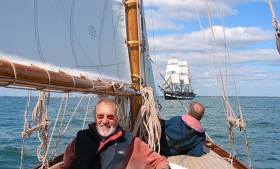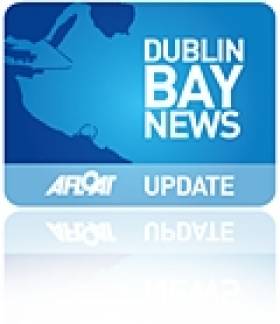Displaying items by tag: Traditional Boat Rally
Dun Laoghaire Regatta Casts Net To Celebrate Kingstown Bicentenary
There could well be as many opinions as to what constitutes a true classic or traditional boat as there are owners of these often highly individual craft. As part of the celebration of the Bicentenary of Dun Laoghaire Harbour – where the first stone was officially laid by the Viceroy on 31st May 1817 - the organisers of the Volvo Dun Laoghaire Regatta 2017 (it’s from July 6th to 9th) will be including a Classics, Traditional and Old Gaffer section. This will, in addition to putting extra emphasis on older classes already regularly involved such as the Glens, the Mermaids, the Howth 17s, the IDRA 14s and the Water Wags, be extending a welcome to older boats of other types, and to classic classes from Ireland and around the Irish Sea. W M Nixon reports on progress in this special feature of a very attractive new dimension to Ireland’s biggest sailing event.
If you want anything done in introducing a new twist to sailing, make Cathy MacAleavey the organiser of the special sub-committee in charge of moving things along. And if you want to be sure things are going in the right direction as regards classics and traditional craft, make sure that that Hal Sisk is being consulted and will be personally involved in one or maybe all of his classic craft, for the contribution he has made to the appreciation of our boat heritage in Ireland is unmatched.
Former Olympic sailor and round Ireland record holder Cathy is now herself very much a mover and shaker in the classics, as she has built a Water Wag and a Shannon One Design working alongside the great Jimmy Furey of Leecarrow in Roscommon, and races regularly in both classes.
On being appointed to this completely new post last Autumn by top honcho Tim Goodbody, Chair of the overall Organising Committee, one of the first things she remembered was that while taking part in the Glandore Classics some years ago, she’d been much taken with the Fife One Designs from the Menai Straits, little gems some 24ft 6ins LOA whose design origins go back to 1926, and have been thriving as a class since the 1930s.
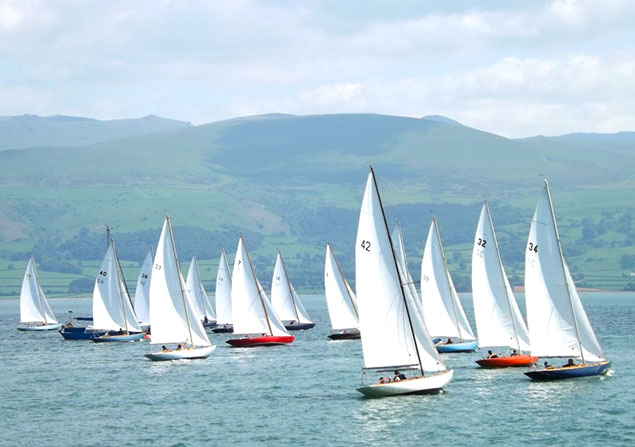 The Royal Anglesey Fifes racing in the Menai Straits. Although the class was first designed in 1926, and gained full strength early in the 1930s, this will be their first visit to Dun Laoghaire. Photo: Ian bradley
The Royal Anglesey Fifes racing in the Menai Straits. Although the class was first designed in 1926, and gained full strength early in the 1930s, this will be their first visit to Dun Laoghaire. Photo: Ian bradley
These days they hunt as a pack and many of them are well organised for road trailing, so on the assumption that they would be heading to the Glandore Classics 2017 on July 23rd, she sent an email to class chairman Richard Tudor suggesting that they might like to take in Dun Laoghaire on the way. It turns out that they won’t be at Glandore in late July as they’re expected to take part in the four yearly Celtic Festival in the Menai Straits at much the same time. But their diary was reasonably clear for the 6th to 9th of July and the Dun Laoghaire festivities, and they’re coming to race for the new Kingstown Cup big time.
This is doubly interesting, for they’re very much a William Fife design and only six inches shorter than the Alfred Mylne-designed Glens, yet the two comparable classes have never raced in the same event. Needless to say the chances of an inter-fleet race in Dun Laoghaire is now high on the agenda.
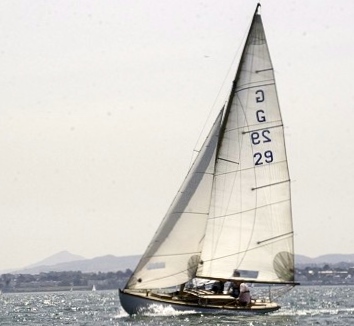 An Alfred Mylne-designed Glen Class OD on her home waters of Dublin Bay in the kind of conditions everyone hopes for in July 2017.
An Alfred Mylne-designed Glen Class OD on her home waters of Dublin Bay in the kind of conditions everyone hopes for in July 2017.
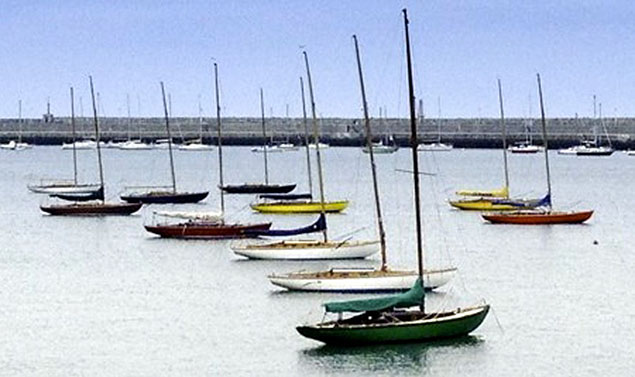 The Glen class neatly demonstrate their need for traditional moorings in their allocated area off the Royal St George YC
The Glen class neatly demonstrate their need for traditional moorings in their allocated area off the Royal St George YC
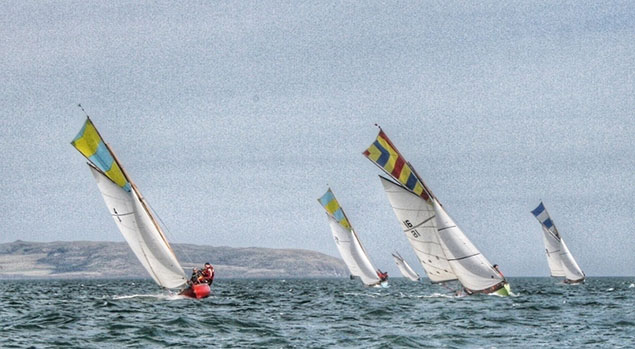 The 1898 Howth 17s will be coming in force from Howth, but they’ve adapted the programme to suit their needs, with a race from Howth to Dun Laoghaire on the Friday, a full day’s racing on the Saturday, a morning race on the Sunday, and then a race home after the prize-giving ceremony.
The 1898 Howth 17s will be coming in force from Howth, but they’ve adapted the programme to suit their needs, with a race from Howth to Dun Laoghaire on the Friday, a full day’s racing on the Saturday, a morning race on the Sunday, and then a race home after the prize-giving ceremony.
So at a stroke, Cathy had given wings to the new event. But at the same time she was casting a fly over Hal Sisk, against whom she regularly races in the Water Wags, but who had his 1894 Watson-designed, Hilditch-built 36ft classic gaff cutter Peggy Bawn on the market, as more than ten years have elapsed since his team completed the wellnigh perfect restoration of this boat in 2005.
Peggy Bawn had been based in Dun Laoghaire Harbour continuously since 1919, and then after her restoration, she became a much-admired feature in classic regattas on both sides of the Atlantic. To say that Hal Sisk has done his duty by her is under-stating the case, yet when Cathy approached him about making Peggy Bawn the centrepiece of the VDLR Classics Regatta, he said he’d already decided to do so, and was looking forward to it very much.
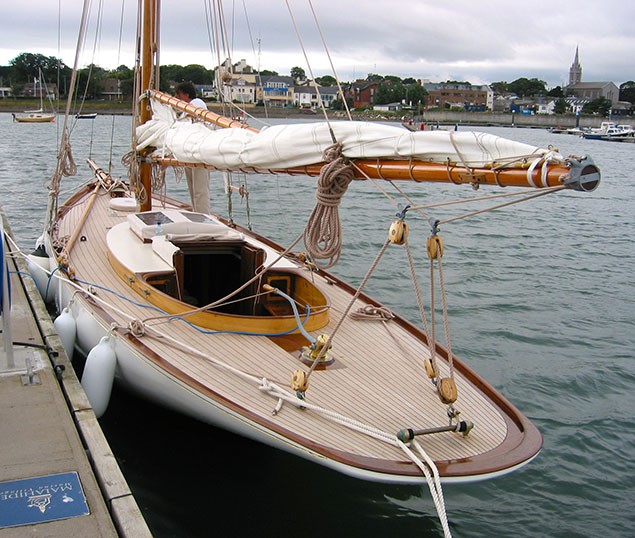 Peggy Bawn in her newly-restored form in 2005. Anyone contemplating a similar project should spend hours studying this image……Photo W M Nixon
Peggy Bawn in her newly-restored form in 2005. Anyone contemplating a similar project should spend hours studying this image……Photo W M Nixon
While all this was going on in the background, one of the members of Cathy’s sub-committee, Guy Kilroy, was constructing a database of all the classic and traditional classes within Ireland or within reasonable reach. Although most of them are very location-specific and few have the trailers for a long road journey, you just never know who might be swept up in the general enthusiasm for an event which is really beginning to buzz, and certainly the exotic Shannon One Designs will be turning up in strength.
Meanwhile, there’s the mysterious territory which is the Old Gaffer’s Association, which came into being in 1963 when people realised there wasn’t any organisation looking after the needs of boats which weren’t really classics in the strictest sense, yet fitted into so many other categories that they almost defied definition.
Ironically, the OGA was founded in the very year that Dublin Bay’s perfect exemplars of the gaff-rigged racing cutter, the Dublin Bay 21s, changed over to Bermudan rig. Yet as the 2013 Golden Jubilee Round Britain and Ireland cruise of the OGA showed, the Old Gaffers thrive as never before. And as it happened, in 2015 and 2016 the President of the overall Old Gaffers Association was Dun Laoghaire’s own Sean Walsh, owner-skipper of the very gaff-rigged Heard 28 Tir na nOg.
But Sean was due to stand down as President in London in January 14th 2017 – last weekend, in other words. Fortunately, there was just time to convene a meeting of key people before that happened, and a gathering in the NYC of Sean Walsh, Dublin Bay OGA President Denis Aylmer, Ian Malcolm of the Howth Seventeen and Water Wag classes, and Cathy MacAleavey and her husband Con Murphy, did a lot to improve mutual understanding and clarify the in-port needs of Old Gaffers, which are different from those of Classics, which are in turn very different from those of easily-manoeuvred modern craft with auxiliary engines.
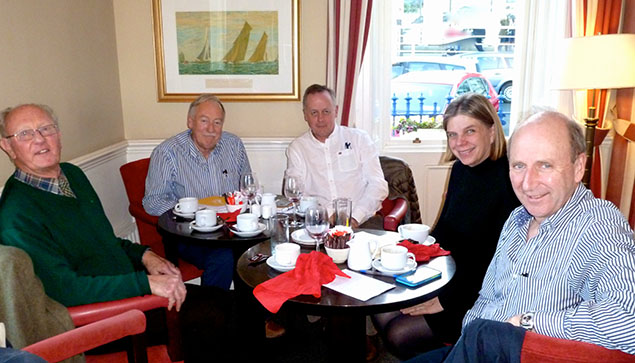
Even before Sean and his team had left for London for the OGA changeover, the word had come through from Paul Keogh, skipper of the Clondalkin community-owned-and-built full-size Galway Hooker Naomh Cronan, that he and his crew would be delighted to take part in Dun Laoghaire in July.
This was another key decision, for the Naomh Cronan is now the only full-sized traditional Galway type on the Irish Sea. But while the great hooker voyager Paddy Barry now sails the seas in a 45ft Frers-designed cutter, it was also confirmed that he too would be taking part, as crew aboard Sean Walsh’s Tir n nOg.
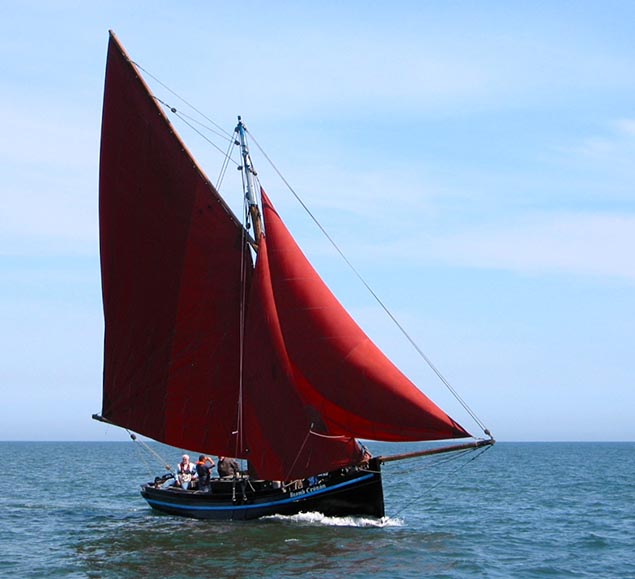 The Clondalkin community-built Galway Hooker Naomh Cronan. Her commitment to the Dun Laoghaire Traditional regatta has greatly encouraged the organisers. Photo: W M Nixon
The Clondalkin community-built Galway Hooker Naomh Cronan. Her commitment to the Dun Laoghaire Traditional regatta has greatly encouraged the organisers. Photo: W M Nixon
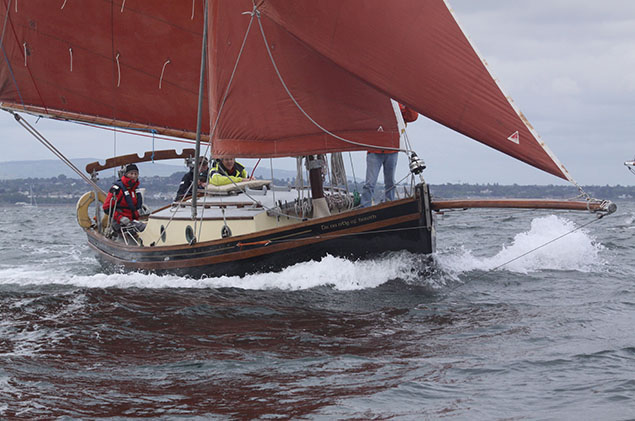 Sean Walsh’s Heard 28 Tir n nOg in racing mode. In Dun Laoghaire in July 2017, his crew will include legendary Galway hooker voyager Paddy Barry. Photo: Dave Owens
Sean Walsh’s Heard 28 Tir n nOg in racing mode. In Dun Laoghaire in July 2017, his crew will include legendary Galway hooker voyager Paddy Barry. Photo: Dave Owens
So the main building blocks of a great event are now going into place, and it’s a matter of building on this sound foundation. With the organisers fully aware of the need to provide proper liaison officers for each special group or class, the need for designated berthing between the Carlisle Pier and the East Pier is also being addressed, as it is the most suitable space, and has the bonus of providing the best possible public view of some of the most interesting-looking boats around.
Thus invitations are on their way to the likes of Scott and Ruth Metcalfe with their characterful schooner Vilma on the Menai Straits, and Mike Clark with his traditional Manx nobby White Heather at Peel in the Isle of Man.
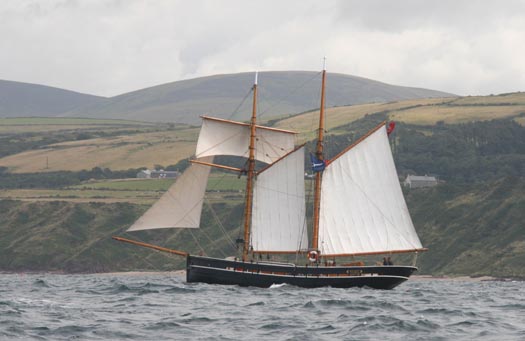 The Menai Straits-based schooner Vilma (Scott & Ruth Metcalf) is exactly the kind of vessel the Dun Laoghaire event is aimed at. Photo: W M Nixon
The Menai Straits-based schooner Vilma (Scott & Ruth Metcalf) is exactly the kind of vessel the Dun Laoghaire event is aimed at. Photo: W M Nixon
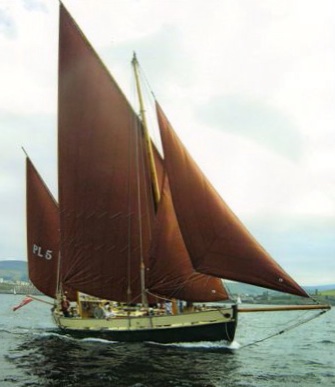 Mike Clark’s Manx Nobby White Heather
Mike Clark’s Manx Nobby White Heather
At the other end of the Isle of Man is Joe Pennington with his restored Manx longliner Master Frank, an asset to any regatta, while across in Strangford Lough Dickie Gomes may have his 1912-built 36ft Kearney yawl Ainmara on the market after 51 years of ownership, but if she doesn’t move he says he is on for Dun Laoghaire.
For several years. Ainmara was Dun Laoghaire-based, but the Dun Laoghaire class which everyone would most particularly welcome back would be the Dublin Bay 24s which raced in the bay from 1947 to 2004. Here’s a rough-cut vid from their final race in the bay in 2004, since then they’ve been taken to Brittany in hope of restoration, but only one has had the complete job done. Originally called Periwinkle, she is now re-named Grace, and is based at Douarnenez, but if she could be persuaded back to Dublin Bay for July 2017, who knows what doors might be opened.
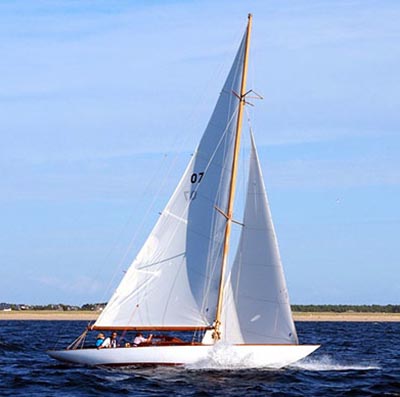 The restored Dublin Bay 24 Grace (ex-Periwinkle) is now reported to be based in Douarnenenz, but she would be very welcome back in Dublin Bay
The restored Dublin Bay 24 Grace (ex-Periwinkle) is now reported to be based in Douarnenenz, but she would be very welcome back in Dublin Bay
Boats of a very different kind came centre stage many years ago in another Hal Sisk initiative, the Bantry Boats built to the design of the ship’s longboat left behind in Bantry after the unsuccessful French invasion of 1796. From the new involvement came the Atlantic Challenge, and you’ll find Bantry Boats at many ports, though there are few enough of them in Ireland. But the Dun Laoghaire festivities would provide an ideal opportunity for them, as the final day of the regatta, Sunday 9th July, is also being pencilled in for a full-on traditional rowing competition for the East Coast Skiffs.
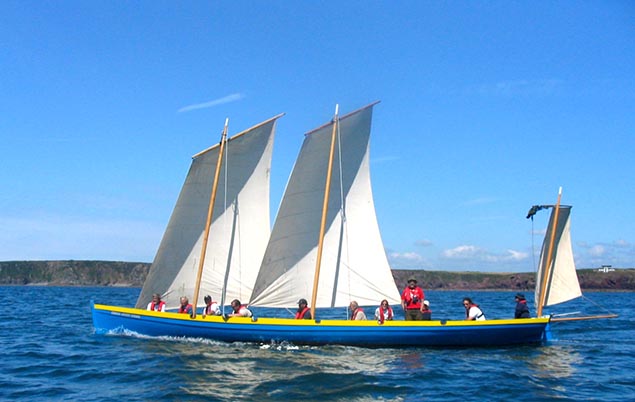 The Pembrokeshire Bantry Boat sailing off the coast of southwest Wales. Some racing for these very special craft is another proposal for the Dun Laoghaire regatta
The Pembrokeshire Bantry Boat sailing off the coast of southwest Wales. Some racing for these very special craft is another proposal for the Dun Laoghaire regatta
In fact, with so much effort being made to provide proper waterfront facilities in Dun Laoghaire, it’s a case of the more the merrier, and another interesting vessel whose management have indicated positive interest is the Conor O’Brien ketch Ilen, currently nearing completion of her restoration through the Ilen Boat Building School of Limerick at Liam Hegarty’s boatyard at Oldcourt near Baltimore.
Ilen is due to be launched in April and will be in full commission by July. The very fact of having a complete suit of new sails will make her look better than she ever has since she was built in 1927, and if she does turn up to Dun Laoghaire welcome, it will be a very different boat from the tired-looking vessel at the end of her working days in the Falkands, the vessel which was finally, thanks to Gary MacMahon’s initiative, returned to Ireland in 1998.
In other words, so many ideas are flying around about the fresh shapes and new vitality that the Kingstown Bicentenary can add to the Volvo Dun Laoghaire Regatta that all things are possible.
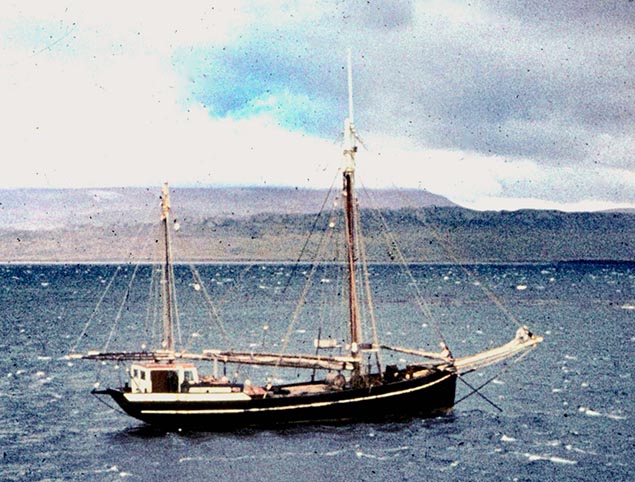 The Conor O’Brien ketch Ilen towards the end of her working days in the Falkland Islands. In fully restored form, she is expected to launch in April of this year, and may well include the Volvo Dun Laoghaire Regatta in her 2017 programme. Photo courtesy Ilen Boatbuilding School
The Conor O’Brien ketch Ilen towards the end of her working days in the Falkland Islands. In fully restored form, she is expected to launch in April of this year, and may well include the Volvo Dun Laoghaire Regatta in her 2017 programme. Photo courtesy Ilen Boatbuilding School
Gaff rigged and traditional boats are welcome to join the Dublin Bay Old Gaffers Association in a celebration of traditional sailing and music and craic on the week-end of May 28th-30th. It is part of Poolbeg Yacht and Boat Club's annual regatta and
festival sponsored by Dublin Port Company.
The weekend will begin with registration and reception on Friday night followed by a race in Dublin Bay on Saturday Starting @11:30 at Poolbeg Lighthouse.
On Saturday evening there will be a Hog Roast, music and craic until late.
Sunday will include the Blessing Of The Boats at Poolbeg followed by a Parade of sail up through the East link and the Samuel Beckett Bridges and returning back down to Poolbeg Marina.
Prize giving will take place @17:00 hours in Poolbeg Club house. Sunday evening will conclude with Music and socialising .
Poolbeg Yacht and Boat Club Have Kindly agreed to facilitate all registered and participating boats, free berths on the Marina for the week end.


























